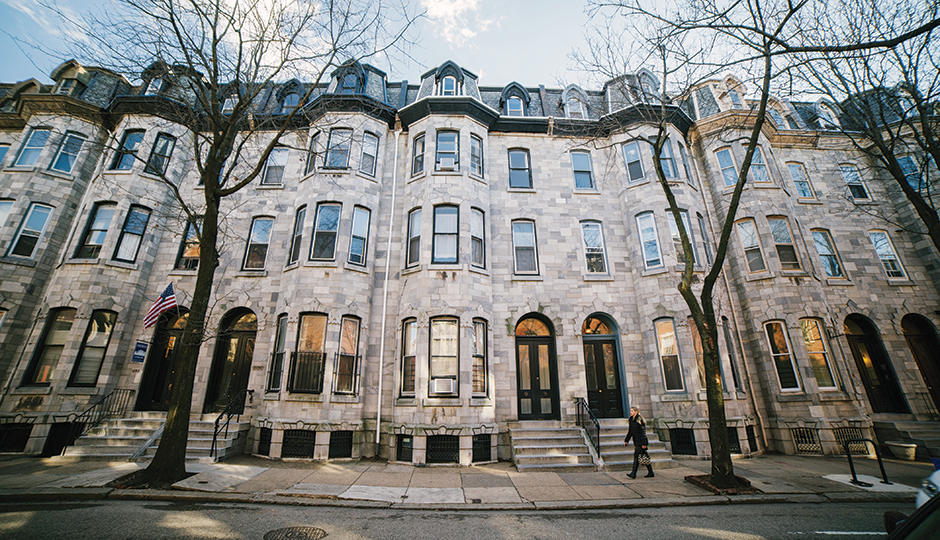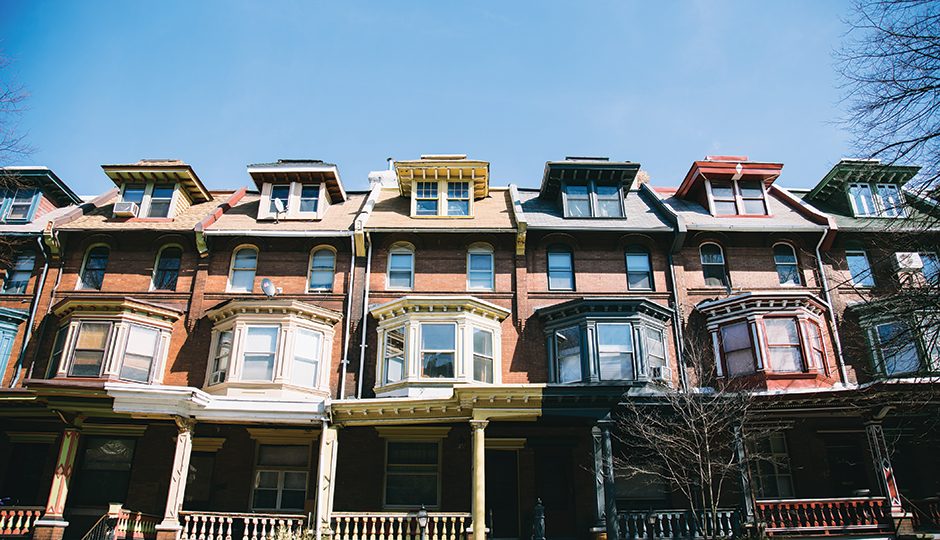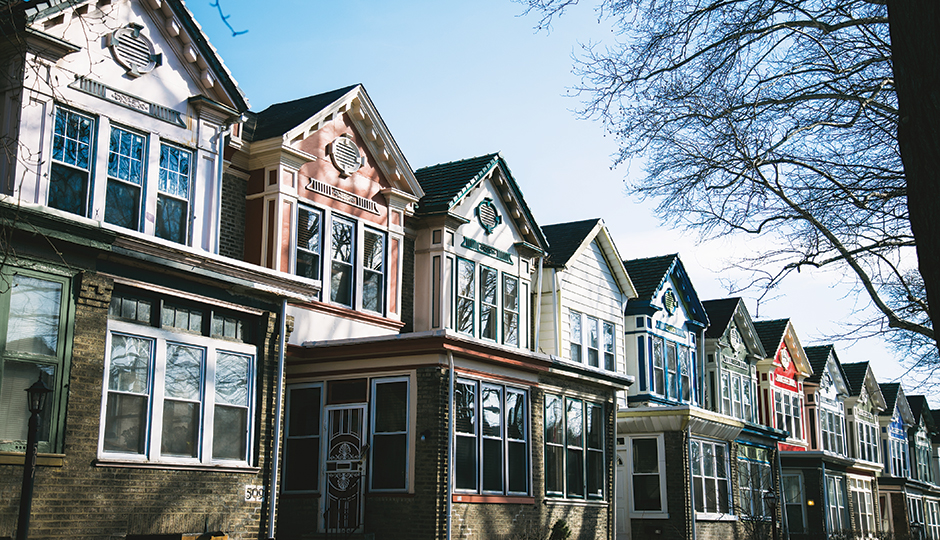The Rowhome Is Us

Grad Hospital | Photography by Cory J. Popp.
Back in 1954, my neighbor John paid $8,000 for a 1,200-square-foot rowhome, one of 30 identical homes on the block, all built in the 1930s by the same developer. Over the next six decades, he’d share walls with a progression of neighbors that included a trio of police detectives, a beefy Democratic state senator by the name of Lynch, and an avid bird-watcher named Don, who lived next to John for roughly 30 years.
When my husband and I bought Don’s house in 2014, John quickly became a sort of adviser to us, a rowhome Yoda who warned us about the tendency of our houses’ gutters to freeze and knew exactly what to do on that horrific day when our sewage pipe backed up. At 85, he could often be found outside, sweeping both sets of front steps. “It keeps my blood pumpin’,” he would say when we’d try to take over. We’d get home from work on trash day to find he had already brought our cans back up from the sidewalk.
This wonderful, neighborly setup is, as countless Philadelphians can attest, one of the many perks of living in a block of rowhouses: You are never alone in your adventures in homeowning, either figuratively or literally. John, who once carted a field organ around Korea to provide musical accompaniment during Sunday services for his fellow soldiers, now practiced at home on a couple of jury-rigged keyboards; within weeks of moving in, I’d grown accustomed to hearing the muffled strains of hymns through the wall. Sometimes, doing dishes or folding laundry, I’d hum along to the ones I knew.

West Philly | Photography by Cory J. Popp.

Manayunk | Photography by Cory J. Popp.

South Philly | Photography by Cory J. Popp.
OF COURSE, not everyone gets to share a wall with a neighbor like John. You do hear of the occasional rowhome misadventure (floods, fires, pestilence) or some nightmare involving the meshing of lives and properties. One friend of a friend, Patty, bought a house connected to a home whose owner had passed away without a will, resulting in a years-long legal kerfuffle over the empty house. Only the house wasn’t entirely empty: A family of raccoons would come and go freely through the attic, brazenly eating Patty’s porch tomatoes along the way, undaunted by her efforts to chase them with a hose.
My point here is this: Whether you love your neighbors, hate them or chase them around with a garden hose, when your houses are connected, so are your experiences, your lives — at least on some level. And Philadelphia has more people living in connected houses than any other big city in the country — some 60 percent of us. Even by big-city standards, that’s a lot of life-meshing. We have more rowhomes than they have in Baltimore, D.C. or Boston. Definitely more than New York.
Ah, imposing, hierarchical New York, where the buildings (and the price tags) climb up, up, up into the stratosphere! In Quaker-rooted Philly, we’re more grounded. Blessed with more space and fewer bodies, we’ve always built out more than up, cramming crazy numbers of those connected houses onto tiny parcels of earth — houses and earth that are more affordable to your average buyer by, oh, about a million percent. (Which is why a little over half of us own our own homes, compared to New York’s 32 percent.)
Anyway. There are strict and loose definitions as to what, exactly, constitutes a rowhome, but I think the average Philadelphian would agree with architect Rachel Simmons Schade, who wrote the city’s official rowhouse manual a few years back and defined a rowhome broadly as “a one- to four-story house occupying a narrow street frontage and attached to adjacent houses on both sides.” That encompasses most of what you see in Philadelphia — the teeny trinities and the immense mansions, the porch-fronts, the townhouses, the straight-throughs, the workingman’s row, the G-Ho special. In the 325 years since someone built the first rowhomes on Front Street in Old City, the model has clearly deviated quite a lot. But Philly’s devotion to the rowhome hasn’t.
And why should it? It works — at least, most of the time, over time, it has. Even now, in the midst of a frenetic Center City building boom that has condos shooting up like gleaming glass Lego towers, boasting things like yoga lounges and saltwater pools — even now, they’re still building rowhomes. Because rowhomes are in our DNA. Sure, some of the newer models have vocal detractors, but the rowhouse still endures, because it has for so long created, reflected and reified how we live, who we are as a people. As a city. You know — down-to-earth, scrappy, stoop-sitting, real-talking, pennywise, not-New-York, up-really-close-and-personal Philadelphia. City of Brotherly Love, And Also Party Walls.

Fitler Square | Photography by Cory J. Popp.

Northeast Philly | Photography by Cory J. Popp.

West Philly | Photography by Cory J. Popp.
WE WERE, for a time, also the City of Homes.
That’s what they called us at the turn of the 19th century, when a model of Philadelphia’s ubiquitous two-story, $2,500 “Workingman’s House” was put on display at the Columbian Exposition in Chicago. (Picture your average smallish South Philly rowhome; that’s what we’re talking about.) Exhibition attendees (there were some 25 million of them) marveled at this appealing alternative to the depressing tenements that populated other cities, delighted by the home’s relative comfort, the efficiency, the accessibility.
Journalist Talcott Williams wrote effusively about the house:
There is nothing more wonderful in all that marvelous Exposition than this proof that the laws, the habits, and the businesses of a city of one million people can be so arranged that even the day-laborer earning only $8 or $10 a week can own the roof over his head and call no man landlord. The result of all this is that Philadelphia is not a city of palaces for the few, but a city of homes for the many.
Sure, the house wasn’t really so “magnificent,” Williams allowed, but it was nevertheless “a triumph of right living in a great city, as the world never saw before.”
I don’t know whether the Philadelphians of 1893 thought of themselves as triumphant, necessarily, but there was no denying even then that the rowhome was a natural fit here. No matter that poor William Penn had designed a spacious, sprawling “greene country towne.” All that gridded sprawl turned out to be so easily subdivided that Penn’s idyllic vision never stood a chance. Especially once it became clear that rowhomes were so cheap(ish) to build, owing to the way Philadelphia landowners leased plots to people who wanted to build, and also because replicating one design in one spot with one set of workers was so cost-effective. (This is still true.)
And because they were cheap(ish) to build, rowhouses were also cheap(ish) to buy, at least if they were modest in scale, like the trinities were, with just three rooms stacked up on each other like blocks. (There were plenty that weren’t modest, too — big Federal or Georgian four-stories like you see in Society Hill, built for people who didn’t need cheapish.) Furthermore, the city’s level, rectangular plot of land allowed it to keep expanding outward as the population exploded — tripled! — in the early 1800s. By the end of that century, St. Joe’s University historian Randall Miller says, things like steel and elevators and new plumbing had made building upward possible. “But by then, Philly had grown so much through a flatter development, and that was our character,” he says. “A city of rowhomes.” Our fate — and possibly, by extension, the house you live in right now — had basically been settled.
Meantime, all the homeowners living in all those rowhomes had been working to turn us into a people who are, shall we say, invested.
“There was the sociological idea that home-owning people were committed to the neighborhood, more stable,” Miller tells me. (This, too, is still true.) Rowhomes themselves helped create communities, he adds, because those stable people had their homes, churches and businesses right there in the neighborhood. And also, he says, because of the porch culture. “The porch culture — dictated by design — meant that you were aware that you were living with other people, even depending on other people. The intimacy reinforced the sense of community.”
The porch culture! Has there been anything so influential in this town as our stoops, our porches, our patios? No, there has not. We leave our private houses, and we spill out into this alternately adored and cursed shared space, and that’s where it all happens. (It being the unofficial neighborhood watch and our kids playing with each other and the fights over un-minded dog doo and the impromptu shared beer and the discussions about who’s going to cut down that dead tree, because we know it’s not going to be the city, harrumph.)

Fairmount | Photography by Cory J. Popp.

Old City | Photography by Cory J. Popp.

Manayunk | Photography by Cory J. Popp.
Even in the 1700s, this is how it was: Small houses pushed people outside, creating what historian Sam Bass Warner in his book The Private City called “the unity of everyday life,” which in turn created a tight community of businessmen, artisans and regular folks, who together were able to “run the town and manage a share of the war against England.”
In Warner’s recounting, our neighborly interactions basically helped shape the entire republic. But his story also sounds a lot like the one a colleague of mine tells about life on Naudain Street in the 1980s, like so many modern Philly stories. “We’d climb up on a milk crate and call over the fence to drink wine with the neighbors,” she says. “One was Kitty, a 65-year-old who drank too much. And there were Val and Leo from Iowa. Under no other circumstances would we all have been friends. But we were.”
TO THE EXTENT that there is grumbling about some of the new rowhome construction (“new” being from, say, 1995 onward), much of it revolves around porch culture.
Don’t get me wrong: People have other issues, too. The new rowhomes are too big, or too ugly. They’re too modular, too cheap, too pricey, too suburban, too other in a place where other isn’t usually a compliment. In January, Inga Saffron wrote in the Inquirer about concerned citizens in Roxborough — not unlike concerned citizens in many other neighborhoods — looking to address the problem of “alien McTownhouses decked out with vinyl siding and gabled roofs.” Instead of the typical gardens and porches, she wrote, these places have “front-loaded garages and concrete parking pads.”
You can see how putting a garage or parking space or small parking lot where once a stoop or sidewalk might have existed could be perceived as a loss. What organic neighborly interaction ever happened in a garage? If you buy into the romantic and civic importance of shared space, as I do, it’s easy to work yourself into a lather over what a little stoop (or lack thereof) means to us all in the long run: Think of the republic, for God’s sake!
But then again, part of the charm of the rowhome has always been its ability to evolve with the needs of the people who are living in it. (I imagine there was plenty of consternation from the Old Guard when, in the 1920s and ’30s, developers built all those deeply unattractive back alleyways for garages, to accommodate the newly popular automobile.) The lack of porches or stoops on some of the new homes might be a shame, but I bet the closets inside are fabulous.
And anyway, regardless of the specifics of the individual architecture — no matter how traditional or trendy, how stunning or schlocky — living in a rowhouse isn’t only about the individual. It’s about the whole. And where the two meet. It is, as my wise neighbor Cece commented, “about feeling like you’re a part of something.”

Kensington | Photography by Cory J. Popp.

West Philly | Photography by Cory J. Popp.
Before I lived on my current block, I’ll admit, I found the sameness of the houses, well, a tad unmagnificent, to borrow from old Talcott Williams. Only after I moved in did I notice how wonderfully personalized each house really is: There’s the one with the stunning mosaic-tiled front porch. The one with the cheery yellow front door. The one with the AstroTurf. We are different, and we are the same, separate and connected. You know. Like the republic.
And speaking of being connected: Our friend John is no longer our neighbor, having moved recently to a retirement home where he shares more than a wall — he shares a room, divided with a curtain. No matter, he says. He’s delighted with his lot.
We visit him sometimes, bringing whatever neighborhood news we have. Many of our other neighbors do, too. And when any of us run into each other on the street, we agree that it’s good to see John well and happy in his new place. And it is. But inside my house, in the quiet of the afternoon, I do sometimes miss the hymns coming from the other side of the wall.
Published as “The Rowhome Is Us” in the April 2016 issue of Philadelphia magazine.


